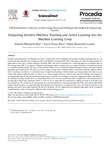Integrating Iterative Machine Teaching and Active Learning into the Machine Learning Loop

Use este enlace para citar
http://hdl.handle.net/2183/29381
A non ser que se indique outra cousa, a licenza do ítem descríbese como Atribución-NoComercial-SinDerivadas 4.0 Internacional
Coleccións
- Investigación (FIC) [1711]
Metadatos
Mostrar o rexistro completo do ítemTítulo
Integrating Iterative Machine Teaching and Active Learning into the Machine Learning LoopData
2021Cita bibliográfica
MOSQUEIRA-REY, Eduardo; ALONSO-RÍOS, David; BAAMONDE-LOZANO, Andrés. Integrating Iterative Machine Teaching and Active Learning into the Machine Learning Loop. Procedia Computer Science, 2021, vol. 192, p. 553-562. https://doi.org/10.1016/j.procs.2021.08.057
Resumo
[Abstract] Scholars and practitioners are defining new types of interactions between humans and machine learning algorithms that we can group under the umbrella term of Human-in-the-Loop Machine Learning (HITL-ML). This paper is focused on implementing two approaches to this topic—Iterative Machine Teaching (iMT) and Active Learning (AL)—and analyzing how to integrate them in the learning loop. iMT is a variation of Machine Teaching in which a machine acts as a teacher that tries to transfer knowledge to a machine learning model. The focus of the problem in iMT is how to obtain the optimal training set given a machine learning algorithm and a target model. The idea is to learn a target concept with a minimal number of iterations with the smallest dataset. Active Learning, in contrast, is a specialized type of supervised learning in which humans are incorporated in the loop to act as oracles that analyze unlabeled data. AL allows us to achieve greater accuracy with less data and less training. Our proposal to incorporate iMT and AL into the machine learning loop is to use iMT as a technique to obtain the “Minimum Viable Data (MVD)” for training a learning model, that is, a dataset that allows us to increase speed and reduce complexity in the learning process by allowing to build early prototypes. Next, we will use AL to refine this first prototype by adding new data in an iterative and incremental way. We carried out several experiments to test the feasibility of our proposed approach. They show that the algorithms trained with the teachers converge faster than those that have been trained in a conventional way. Also, AL helps the model to avoid getting stuck and to keep improving after the first few iterations. The two approaches investigated in this paper can be considered complementary, as they correspond to different stages in the learning process.
Palabras chave
Iterative machine teaching
Active learning
Machine learning
Human-in-the-loop machine learning
Active learning
Machine learning
Human-in-the-loop machine learning
Versión do editor
Dereitos
Atribución-NoComercial-SinDerivadas 4.0 Internacional
Ítems relacionados
Mostrando ítems relacionados por Título, autor ou materia.
-
Improving Medical Data Annotation Including Humans in the Machine Learning Loop
Bobes-Bascarán, José; Mosqueira-Rey, Eduardo; Alonso Ríos, David (MDPI, 2021)[Abstract] At present, the great majority of Artificial Intelligence (AI) systems require the participation of humans in their development, tuning, and maintenance. Particularly, Machine Learning (ML) systems could greatly ... -
Human-in-the-loop machine learning: a state of the art
Mosqueira-Rey, Eduardo; Hernández-Pereira, Elena; Alonso Ríos, David; Bobes-Bascarán, José; Fernández-Leal, Ángel (Springer Nature, 2023-04)[Abstract]: Researchers are defining new types of interactions between humans and machine learning algorithms generically called human-in-the-loop machine learning. Depending on who is in control of the learning process, ... -
A scalable decision-tree-based method to explain interactions in dyadic data
Eiras-Franco, Carlos; Guijarro-Berdiñas, Bertha; Alonso-Betanzos, Amparo; Bahamonde, Antonio (Elsevier, 2019-12)[Abstract]: Gaining relevant insight from a dyadic dataset, which describes interactions between two entities, is an open problem that has sparked the interest of researchers and industry data scientists alike. However, ...






